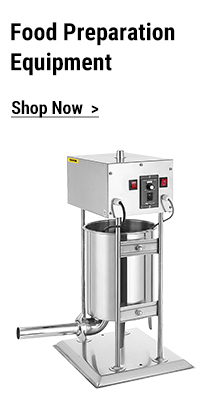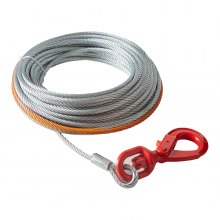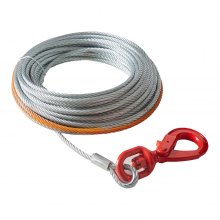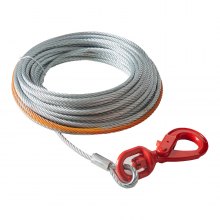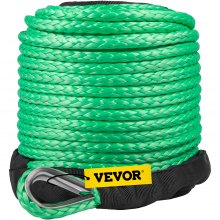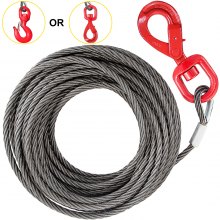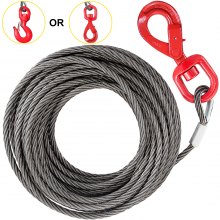Harnessing Innovation: VEVOR’s Synthetic Rope Winches in Off-Road Recovery
For decades, off-road recovery has been a critical aspect of outdoor pursuits, where the resilience of both man and machine is tested against rugged terrain and unforeseen obstacles. In this landscape of adventure, innovation emerges as the driving force, reshaping the boundaries of what is achievable and redefining performance standards.
The advent of nylon rope winches marks a significant departure from traditional steel rope counterparts, heralding a new era of efficiency, safety, and reliability in recycling techniques. VEVOR, a pioneer in equipment manufacturing and outdoor equipment, has winch lines to serve its users.
What is a Synthetic Rope Winch, And How Does It Work?
A winch rope winch is a type of winch system commonly used in off-road vehicles, recovery work, and various industrial applications. Unlike traditional winches that use steel cables, synthetic cable winches use cables made from high-strength alloys such as Dyneema®, Spectra®, or similar materials.
The principle of working winch rope is quite simple:
Attachment
The synthetic rope is securely attached to the winch drum, usually by a spooling mechanism or drum attachment point. The rope is tied in layers around the drum, allowing for even distribution and better alignment during winching operations.
Power Source
The winch is driven and operated by an electric motor or hydraulic system, which provides the torque and rotational force required to operate the drum. Electric winches are fed from the vehicle’s electrical system or an independent battery, while hydraulic winches use hydraulic pressure to drive the motor.
Control Mechanism
The winch is controlled by operators either by remote control or an integrated control system located directly on the winch. These controls allow users to attach or remove winches, adjust cable tension, and control rope movement (in/out).
Winching Operation
When plugged in, the winch motor is activated, rotating the drum. As the drum rotates, the synthetic loop is rotated on the drum (retraction) or compensated from within the drum (extension), depending on the direction chosen by the user.
Factors To Consider When Buying Synthetic Rope Winches
Choosing the right synthetic rope winch requires adequate consideration. Making an informed decision enables you to get the best value for your money and choose the right winch for your needs.
Load Capacity
Specifies the maximum load required for the application you want to activate. Winches have different blades, so choose a winch that can safely handle the weight of the load you expect to encounter.
Rope Length and Diameter
Consider the length and size of the synthetic winch rope required for your applications. Longer fibers provide greater stretch and flexibility, while thicker cross-sections provide greater tensile strength and durability.
Make sure that the length and diameter of the rope and the capacity of the drum are compatible with the strength of the winch.
Speed and Line Pull
Check winch speed and line pull, as these factors determine how quickly and efficiently the load can be moved or recovered. Consider the desired line speed and pulling power required for your specific application, and choose a winch with the appropriate specifications to meet these requirements.
Mounting Compatibility
Make sure the winch cables are compatible with your vehicle or mounting system. Consider factors such as installation location, hardware installation, and any additions or modifications necessary to install the winch safely and securely.
Safety Precautions When Using Synthetic Rope Winches
There are several possible dangers to using a synthetic rope winch. The list of possible problems abounds, from accidents to injuries to equipment damage. However, some steps can help make your synthetic rope winch usage safer.
Avoid Overloading
Do not overload the winch or overload the winch or abuse it, such as with rapid or jerky movements, which may cause overheating, motor damage, or mechanical interruption. Operate the winch in a controlled way and avoid sudden starts or stops.
Monitor Winching Operations
Always closely monitor winching operations and be prepared to respond quickly to unexpected developments or hazards. Keep a good distance from the winch and load when working while in a straight line.
Use Winch Accessories Properly
When using accessories such as expansion straps, screws, and snatch blocks, ensure that they are packed to the intended load and securely attached to the cables and anchor locations.
Follow the manufacturer’s instructions for the safe operation of winch machinery.
Practice Safe Retrieval
After completing a winch, carefully pull the mechanism onto the winch drum, ensuring an even and secure bend. Avoid bunching or overlapping the string on the drum, as this can cause tangling, fraying, or damage when used in the future.
Why Choose VEVOR’s Synthetic Rope Winches?
There are many benefits to synthetic rope winches. From simplifying load carriage and transfer to handling rugged and remote terrains, they are great investments for professionals and individuals alike. Therefore, it is not enough to buy a synthetic rope winch. You must buy a durable one from a reliable manufacturer.
VEVOR's synthetic rope winches offer a winning combination of innovative technology, high performance, safety, efficiency, versatility, and customer satisfaction, making them desirable for users looking for a portable winching solution to over and effective for their off-road, technical, and recreational needs
VEVOR has prioritized user safety by incorporating advanced features into its winch system. Features such as automatic load-bearing brakes, mechanical overload protection, and non-failure mechanisms ensure safe and controlled winching operations. VEVOR winches are designed for ease of use and simplicity, with features like wireless remote control, plug-and-play installation, and easy operation.
FAQs About Synthetic Rope Winches
Are synthetic rope winches suitable for heavy-duty applications?
Yes, rope winches are suitable for various applications, including heavy-duty towing, recovery, and lifting. They provide high tensile strength, durability, and reliability, allowing them to handle demanding conditions and loads. However, choosing a winch with the right load and specification for the intended application is important.
Can I retrofit my existing winch with a synthetic rope?
Replacing the winch with a modified rope and upgrading the necessary components (e.g., fairlead, drum attachment) is usually possible. Still, it is important to ensure alignment and proper installation to ensure safety and activity have continued.
Are synthetic ropes more prone to wear and damage compared to steel cables?
Although manufactured cables are completely resistant to corrosion and deterioration, they are generally more resistant to corrosion, UV corrosion, and chemical exposure than steel cables. Proper maintenance, inspection, and replacement of worn and damaged cables are necessary to ensure a safe and reliable winching operation.


